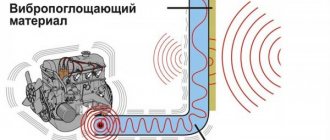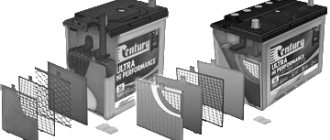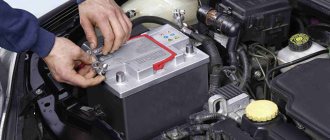The battery plays a major role in all cars because it starts the engine in the vehicle.
The starter begins to work due to the torque, which sets the crankshaft in motion and the engine starts.
There are situations when this becomes an excellent replacement for a non-working generator. But this is only for a short time. While driving, the battery is charged from the generator.
However, despite all this, it is recommended to replenish its energy through other devices. This requires special knowledge of how to properly charge the battery in order to avoid its premature breakdown and maintain its original capacity.
Attention! Under no circumstances is it recommended to completely discharge the battery. This will lead to a decrease in its original characteristics.
Content:
- 1 How long does it take to charge
- 2 How to charge correctly: determine the full discharge
- 3 What to do if you are completely discharged
- 4 How to properly charge with a charger: preparation 4.1 Before starting power, you must perform a number of preparatory steps:
- 8.1 Experts recommend adhering to the following rules:
When the engine is operating, the battery, regardless of its type, is powered by a generator installed in the car. To control the process, the generator uses a relay regulator. This part helps supply voltage to the battery, which is essential for normal operation of the battery.
As a rule, the voltage does not fall below the parameter 14.1 V. The full capacity is gained under the condition of a voltage of 14.5 V. From this we can conclude: the supplied voltage is capable of ensuring the operation of the battery, but it is not possible to fully charge the element. To prevent the battery from completely discharging, experts recommend periodically powering the battery from a full charger.
How long does it take to charge?
The car battery must be powered on board the car itself, and driver participation is usually not required.
But there are situations in which the car is used for long-distance driving, and the battery does not have time to charge. This condition affects service life and is not conducive to durability. To avoid such a problem, it is better to use automatic chargers equipped with an intelligent control system. However, the cost of such a product is quite high, so many motorists continue to use standard chargers.
As a rule, the battery works quite normally at air temperatures above 0°C. Starting the engine in such conditions is not difficult. If the temperature drops, the battery life is reduced several times. In cold weather, starting the engine requires more starting voltage, which is associated with a change in the consistency of the engine oil. It thickens, so the starter needs more power to rotate the crankshaft.
If the car is used within the city, often for short trips, then energy-demanding equipment is put into operation. In this case, the battery is forced to cope with an even greater load, and it is not able to receive the necessary charge from the generator and restore the expended energy. That is why you should regularly feed the battery with a special charger. If the battery is in good condition, you can repeat the procedure approximately once a year until frost arrives.
Helpful operating tips
In order not to wonder whether it is possible to change the electrolyte in the battery, it is better to properly monitor its condition and take into account the basic operating rules. One of the most important is ensuring a balanced temperature regime: when the temperature drops to certain levels, the acid can freeze.
The minimum density of the battery at temperatures up to minus 30 degrees Celsius should be equal to 1.29 g. If the temperature is lower - up to 1.32 g. If there are no optimal indicators, then you will have to restore them by adding sulfuric acid.
The fact is that an electrolyte with a lower density will very quickly freeze and become unsuitable for further use, since any chemical processes will cease to take place in it. As density increases, the freezing point decreases. If it so happens that ice appears inside the battery, you can only hope that it did not deform the lead plates. If damage occurs, the battery will have to be repaired or completely replaced.
Knowing how to properly change the electrolyte in a battery, you can avoid the need to contact a service center and overpay for expensive repairs.
How to charge correctly: determine the full discharge
If the motorist does not have the opportunity to find out the residual capacity, then identifying the moment of full charging is not problematic by using the capabilities of a voltmeter.
During power supply, the voltage at the battery terminals does not increase, which means the element has reached 100% capacity. If you are using a modern product, the terminal voltage should increase to 16.2V (a slight up or down error is allowed). The figure is given approximately, since the exact value largely depends on the supplied current, battery capacity, type of electrolyte and other parameters.
What to do if you are completely discharged
Often, the owner of a vehicle is faced with a complete discharge of the battery due to his own carelessness.
To discharge the battery, it is enough to leave the vehicle with active headlights, interior lights on, or multimedia equipment running. In the morning the owner will discover that the battery is completely discharged. In view of this, the driver is interested in how to charge the car battery in this case? It is no secret that discharging the power component to 0% negatively affects the period of use. Manufacturers who produce such products strongly recommend monitoring their condition, because even a one-time failure to provide timely power can cause the device to fail. According to statistics, even the most expensive battery becomes inoperable after two discharges.
To understand how and how much to charge a car battery, you need to determine how much the capacity has dropped. After which you can connect the charger and charge it as indicated in the instructions. A universal option is to supply current at 0.1 of the entire component capacity.
How to properly charge with a charger: preparation
Before you start eating, you need to perform a number of preparatory steps:
- Remove condensation, corrosion, and dirt from the contacts. Use a soft cloth that can be soaked in either a specialized product or a soda solution. Remove dirt thoroughly;
- Check the condition of the electrolyte. If it is not enough, add clean water, preferably distilled, otherwise the battery will be damaged.
After the above activities, you can begin the nutrition process. This is done using direct current or voltage. Charging time may vary. This does not apply to universal memory devices.
Possible faults
In most cases, car batteries suffer from a problem such as loss of density. The trouble is due to a variety of reasons, namely:
- Aging.
- Sulfation of plates.
- Incorrect maintenance.
The most common factor is considered to be sulfation of the plates, which is caused by a constant lack of proper charging. To understand the principle of destruction, it is enough to remember school chemistry and evaluate the processes that occur in the device.
As you know, inside the battery there are lead grids, which, in turn, are filled with lead dioxide.
During the discharge, reduction of lead oxide begins at the cathode and oxidation (reverse process) at the anode. In simple words - on the plus and minus. In both the first and second cases, the formation of lead sulfate begins, and the density of sulfuric acid rapidly decreases. Many car owners often make a big mistake - having measured the density indicators, they begin to add electrolyte, increasing the density to the required level. As a result, further sulfation occurs and complete damage to the battery .
Experts advise starting to measure density only on a fully charged device with normal acid quality. Even if the built-in battery indicates 100% charge, it may not be accurate.
How to charge with a charger and how long will it take?
To understand how to charge a car battery with a charger, you should follow several rules.
The battery is a source of constant current. To avoid making mistakes when connecting, observe the polarity using the “+” and “-” markings indicated on the battery. The terminals on the charging have the same markings. “+” connects to “+”, “-” to “-”.
Important! Incorrect connection without observing polarity will damage the battery. Instead of energy, it will be discharged, up to a deep discharge. The consequences of the error can only be eliminated by installing a new element!
Before connecting to external charging, the battery should be removed and cleaned of accumulated dust and dirt. Acid leaks can be easily removed with a damp sponge and soda. Use a few tablespoons of baking soda and a glass of water.
If we are talking about a serviceable battery, unscrew the plugs to release the gases accumulated inside.
Purpose of the battery
As you know, the battery is an expensive part of vehicles, so buying a new one when the old one is damaged or the performance has decreased is not a very smart decision.
Fortunately, replacing the electrolyte in the battery can be a way out of this unpleasant situation. If this procedure is performed correctly, then in a short time it will be possible to return the battery to its previous performance. Every motorist knows that the battery design looks extremely simple and includes a number of simple components. Among them:
- Lead plates that cover the entire body.
- Electrolyte is a special liquid that is considered the connecting element between these plates.
As a result of a chemical reaction, two elements accumulate and conduct electric current.
Given the importance of the role of the electrolyte, its volume and quality can determine the final performance properties of the battery .
We are talking not only about the indicators of generated energy, but also voltage. If the level of the substance begins to decrease and the quality decreases, this can significantly deteriorate the performance of the battery. Deformation of lead plates is considered a fairly common phenomenon, and it is the decrease in the quality of the electrolyte that causes the chemical reaction to weaken. Ultimately, precipitation, cloudiness and all kinds of evaporation occur in the battery, which leads to such troubles as the lack of interaction between the elements to generate energy. To restore the part to its former efficiency, it is important to replace the fluid as quickly as possible.
How to charge if there is no charger
The simplest method of powering a component is to light it from another machine. After this, you need to travel by car for at least half an hour.
The main success factor is considered to be crankshaft speed, varying from 2900 to 3200 rpm.
At these parameters, the generator supplies direct current, which resuscitates the power source. Important! This method is only relevant if the battery is partially discharged. If the battery is deeply discharged, it is still necessary to fully charge the battery.
How to charge a battery if there is no charger
Car owners are often interested in how to properly charge a car battery without a charger.
Sometimes power supplies from computer equipment or mobile devices are used as a replacement. It is no secret that the main condition for supplying current is the presence of voltage, the value of which is slightly higher than the voltage at the battery outputs. Example: the component output parameter is 12 V, and the charger voltage should not be lower than 14 V. At the same time, the equipment voltage often does not exceed 7 V.
Suppose you have a charger with a voltage of 12 V on hand, there will be a problem in the form of the protection system in third-party power supplies triggering, so charging will not supply current to the recipient. If such protection is absent, the adapter is highly likely to fail due to excessive load.
Experts also do not recommend powering the battery from chargers that have the required voltage, but do not have the function of adjusting the parameters of the output current. That is why a car battery can only be charged using a specialized device.
Car battery charging period
First, pay attention to its tension. If this indicator is in the range of 12.6V - 12.9V when the engine is not running, then the condition is still optimal.
Every car owner must have this information. This especially applies to beginners (as opposed to “old people” who are already experienced in this matter).
In practice, it has been proven that it is rarely possible to keep the battery 100% charged. In this case, it is allowed to operate it at a voltage of 12.2V. But if the battery is discharged more than this value, then it is definitely worth charging it.
This applies to the interval 11.8V -12V. The maximum charge of the car battery corresponds to 12.7 Volts. A decrease of 0.5V means it is half charged.
The lowest possible value is 10.8V. This means that this condition should be avoided.
In the future, this will have a bad effect on the power source and will significantly shorten its service life. If your car does not start, then charge the car battery. Battery problems are also indicated by weak lighting of the dashboard or dim headlights, or the audio system is acting up.
How to charge with a charger: staying safe
Having figured out how and how much to charge a car battery with a charger, you need to take care of your personal safety so that the starting process goes without unnecessary problems.
Experts recommend adhering to the following rules:
- When working with a battery, do not light a fire near it - this may cause an explosion of hydrogen, which is released by the component during the power process;
- Do not neglect to observe the polarity, as incorrect connection can cause a short circuit and complete inoperability of the battery;
- Try not to overcharge the battery, as in the process it will overheat and the internal contents will boil away;
- Feed the battery on a flat surface that will not deteriorate from the negative effects of acid, since in theory, vapors mixed with drops of acid can come out of the ventilation hole;
- Charge the component and do not leave it unattended;
- To supply power, the part does not need to be removed from the vehicle, but the hood should be kept open - this is safe;
- If the battery gets too cold, give it time to thaw;
- Follow the manufacturer's recommended current level. It should be equal to 10% of the battery capacity;
- The battery is powered only in a room where it is possible to open windows/doors for ventilation;
- How long does it take to charge a car battery with a charger? Until gas begins to form in the cells;
- At the end of the power supply, wait 20 minutes for gas to escape from the battery.
When, under normal driving scenarios, a recently revived power component shows symptoms of being low, it should be diagnosed and the electrical equipment inspected and tested. In this case, there are several options: the battery has exhausted its entire resource and needs to be replaced, or the car system does not power it. By the way, restoring electrical equipment costs a little less than purchasing a new battery.
Replacement features
Unfortunately, not all motorists know whether it is possible to change the electrolyte in the battery of their vehicle. In addition, among more experienced specialists there are disagreements about the need for this procedure. There are two opinions:
- Replacing the electrolyte is completely useless and even dangerous. It's better to buy a new element.
- Replacing the electrolyte is the key to successful battery operation and is a very important action that should be carried out as often as possible.
In principle, both statements have the right to life.
If you have the financial means, buying a new battery is an excellent solution, since the new model will work much more efficiently than the old one, even a refurbished one.
But not every car owner can afford such an expensive pleasure, so all that remains is to replace the electrolyte on time and try to monitor the condition of the battery. We recommend: Characteristics and cost of batteries model 6ST-90 You should start replacing the fluid inside the battery only under the following circumstances:
- If it becomes cloudy and loses its base shade.
- If a characteristic sediment appears at the bottom.
- If its level has dropped significantly. By the way, in this case, you can simply add electrolyte, but there should be no sediment or cloudiness at all.
In the absence of such problems, it is strictly prohibited to replace the electrolyte by independent efforts, without having the appropriate experience.
Any mistake can cause serious damage to important components of the car, as well as a decrease in the efficiency of the battery. But if the node’s productivity is low, proper replacement may be the best “resuscitation.”











